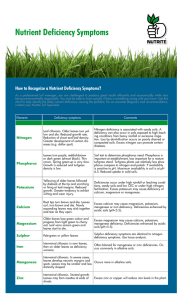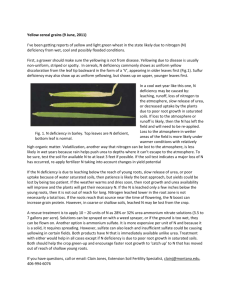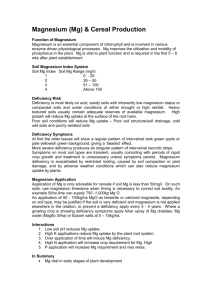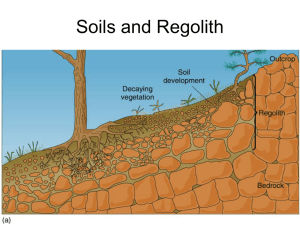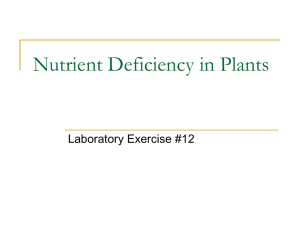Copper (Cu)
advertisement
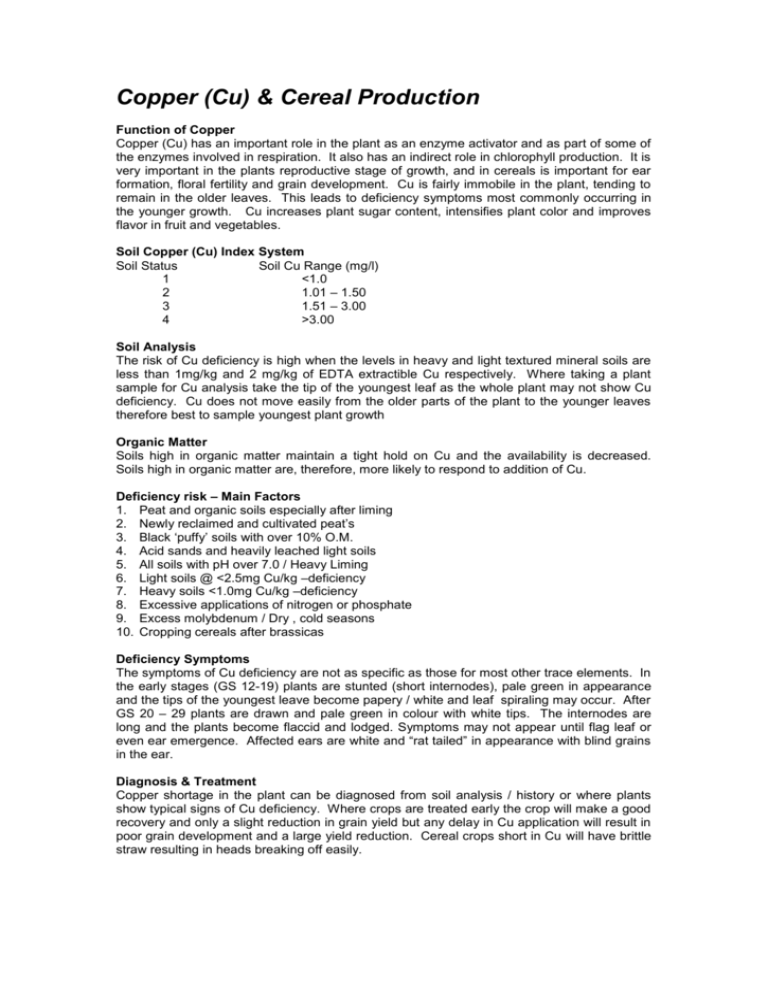
Copper (Cu) & Cereal Production Function of Copper Copper (Cu) has an important role in the plant as an enzyme activator and as part of some of the enzymes involved in respiration. It also has an indirect role in chlorophyll production. It is very important in the plants reproductive stage of growth, and in cereals is important for ear formation, floral fertility and grain development. Cu is fairly immobile in the plant, tending to remain in the older leaves. This leads to deficiency symptoms most commonly occurring in the younger growth. Cu increases plant sugar content, intensifies plant color and improves flavor in fruit and vegetables. Soil Copper (Cu) Index System Soil Status Soil Cu Range (mg/l) 1 <1.0 2 1.01 – 1.50 3 1.51 – 3.00 4 >3.00 Soil Analysis The risk of Cu deficiency is high when the levels in heavy and light textured mineral soils are less than 1mg/kg and 2 mg/kg of EDTA extractible Cu respectively. Where taking a plant sample for Cu analysis take the tip of the youngest leaf as the whole plant may not show Cu deficiency. Cu does not move easily from the older parts of the plant to the younger leaves therefore best to sample youngest plant growth Organic Matter Soils high in organic matter maintain a tight hold on Cu and the availability is decreased. Soils high in organic matter are, therefore, more likely to respond to addition of Cu. Deficiency risk – Main Factors 1. Peat and organic soils especially after liming 2. Newly reclaimed and cultivated peat’s 3. Black ‘puffy’ soils with over 10% O.M. 4. Acid sands and heavily leached light soils 5. All soils with pH over 7.0 / Heavy Liming 6. Light soils @ <2.5mg Cu/kg –deficiency 7. Heavy soils <1.0mg Cu/kg –deficiency 8. Excessive applications of nitrogen or phosphate 9. Excess molybdenum / Dry , cold seasons 10. Cropping cereals after brassicas Deficiency Symptoms The symptoms of Cu deficiency are not as specific as those for most other trace elements. In the early stages (GS 12-19) plants are stunted (short internodes), pale green in appearance and the tips of the youngest leave become papery / white and leaf spiraling may occur. After GS 20 – 29 plants are drawn and pale green in colour with white tips. The internodes are long and the plants become flaccid and lodged. Symptoms may not appear until flag leaf or even ear emergence. Affected ears are white and “rat tailed” in appearance with blind grains in the ear. Diagnosis & Treatment Copper shortage in the plant can be diagnosed from soil analysis / history or where plants show typical signs of Cu deficiency. Where crops are treated early the crop will make a good recovery and only a slight reduction in grain yield but any delay in Cu application will result in poor grain development and a large yield reduction. Cereal crops short in Cu will have brittle straw resulting in heads breaking off easily. Foliar application Apply foliar Cu spray at early (GS 10 -21) to late tillering (GS 29). Late tillering to early boot stage is the most effective time to apply Cu as a spilt application. Winter cereals Where there is a history of Cu deficiency, it is recommended to make an application close to winter dormancy and a second application as soon as active spring crop growth recommences. Spring Cereals On Cu deficient soils apply Cu at GS 10 – 21 and follow up with a second application at GS 31 – 49. Interactions Very high levels of phosphorus & Molybdenum may reduce Cu availability. High levels of N application may cause more Cu uptake by the plant. The uptake of Cu can be either increased or decreased, depending on the relationship with other micronutrients as aluminum, zinc, iron and manganese.
